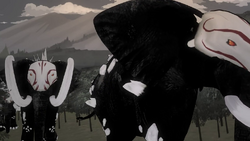Goliaths are huge, armored, elephant-like creatures of Grimm.
Appearance
These Grimm bear much resemblance to modern day African Elephants. They have a primarily black body, with giant, white tusks, and a white and red patch on their foreheads. Like most Grimm, they have bony, white protrusions on their bodies, with a massive row of them going down their spines.
The Goliath is one of the largest land-based Grimm seen yet, standing at 20 stories tall at the shoulders.[1] They also seem to travel in herds, as seen in "Search and Destroy".
History

A herd of Goliaths in the wasteland outside Mountain Glenn
They are seen briefly in "Search and Destroy", during the latter half of the episode, in which Bartholomew Oobleck and Ruby Rose observe a herd walking around the borders of the abandoned city of Mountain Glenn. Oobleck states their lack of hostility, due to their learning of the consequences of human conflict.
Yet despite this unusual display of restraint, Goliaths still never seem to stray far from the Kingdoms' borders. When Ruby asks why, Oobleck simply states that they're "waiting"; however, what exactly they are waiting for is currently unknown. One member of the herd appears to notice Oobleck and Ruby, glaring at them for a short period of time before rejoining its herd.
In "Fall" and "PvP", a few Goliaths travel through Mountain Glenn's streets towards the city of Vale's immediate borders. Goliaths are seen entering the ruined Beacon Academy in "End of the Beginning".
Abilities and Powers
These Grimm's abilities are currently unknown; however, it is known that they possess great power (to the point where even shots from a sniper rifle would be only a minor irritation) and a greater intelligence than the average Grimm (learned over the span of hundreds of years), as they stopped attacking humans once they figured out that repeated attempts to kill them resulted only in death.
Trivia
- The Goliaths seem to be based on African elephants, based on their ear size.
- Its curved tusks more closely resemble those of mammoths, rather than modern-day elephants.
References
- ↑ Volume 2 Director's Commentary [timestamp needed]
| Minor Combatants | ||||||
|
